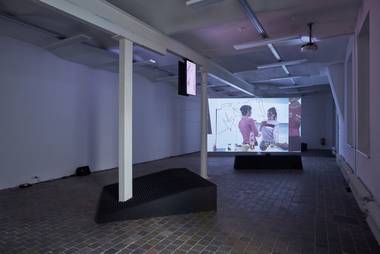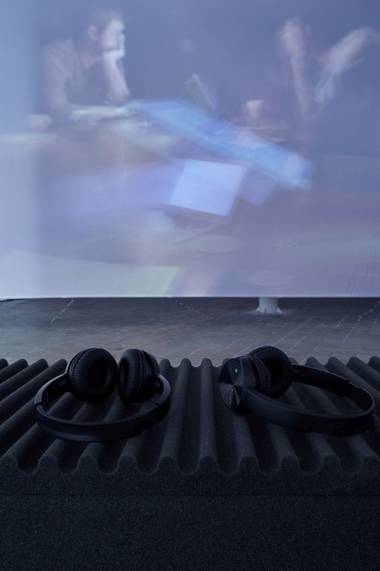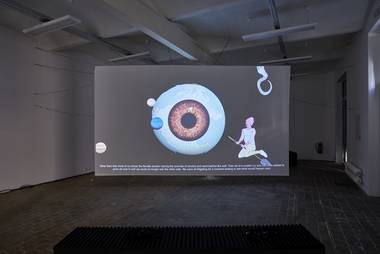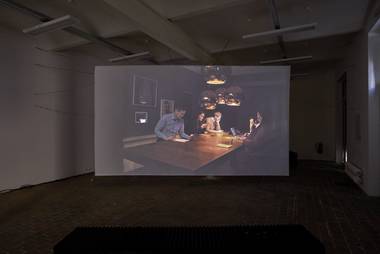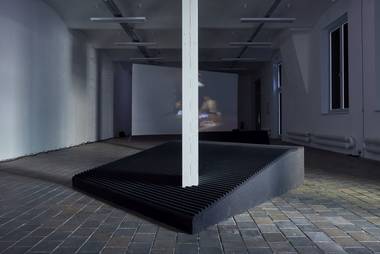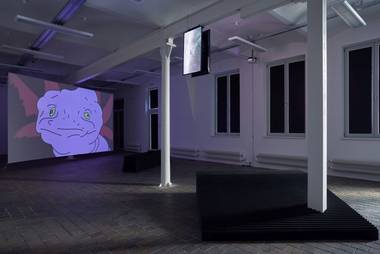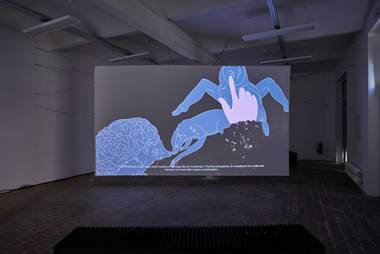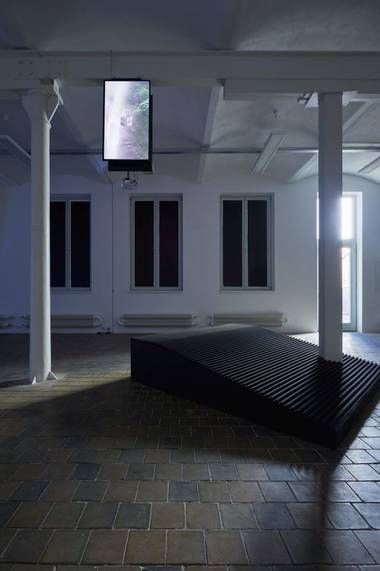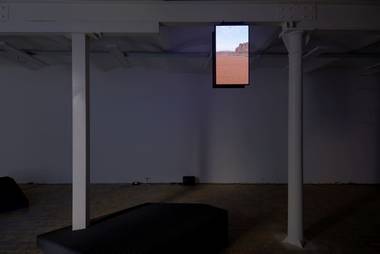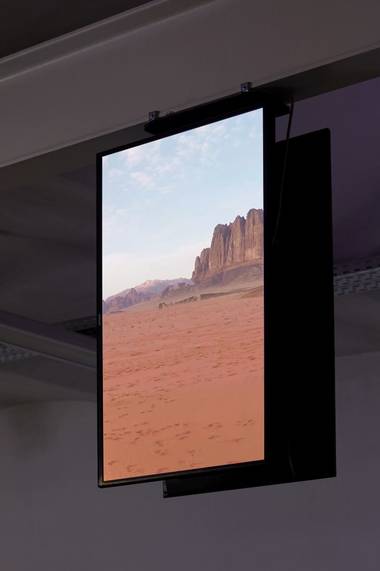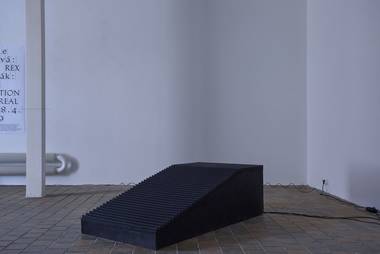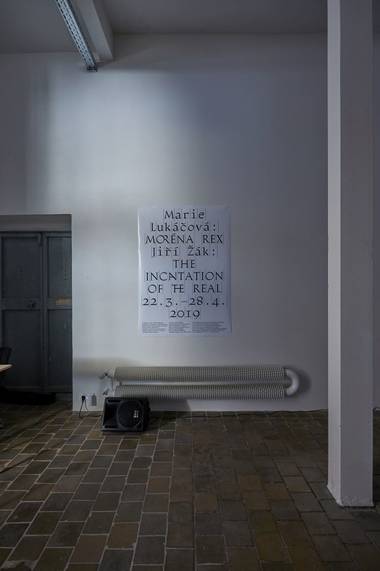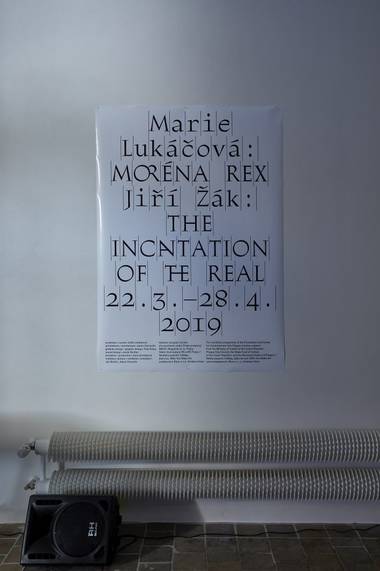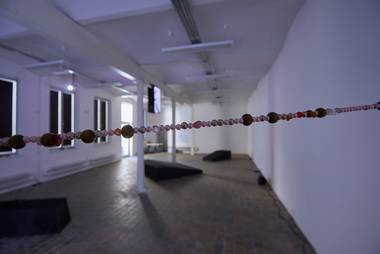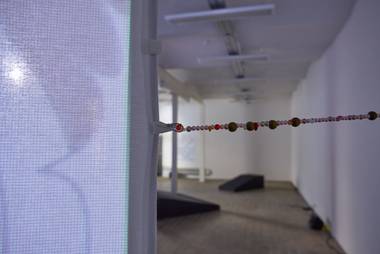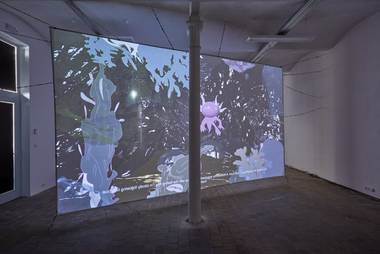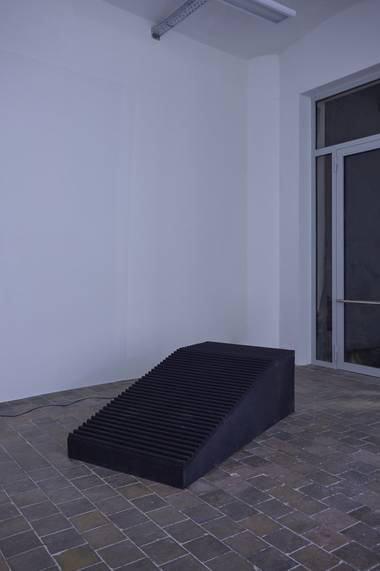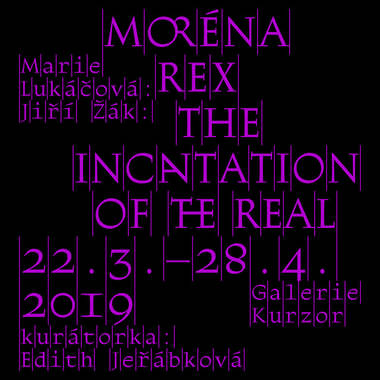Marie Lukáčová: Moréna Rex &
Jiří Žák: The Incantation of the Real
March 22 – April 28, 2019
opening: March 21, 2019
curator: Edith Jeřábková
performance: Yazan Set Abouha
Marie Lukáčová interviewed by Edith Jeřábková
Moréna Rex (Moraine Rex) by Marie Lukáčová, was created specifically for the Cursor Gallery and is part of a series of rapping videos that were recently exhibited at the Futura and Kostka galleries.
The title Moréna Rex is the key to understanding your exhibition. It sounds like the name of a female rapper and is a composite of two words evoking big themes. Moraines are glacially formed accumulations of unconsolidated debris, while the word rex has multiple associations that refer mainly to power and patriarchy, as well as to pre-democratic forms of state organisation, to empires and kingdoms. Is your aim to draw on the social imaginary of women with magical powers in order to reflect upon a specific societal transformation?
I think a lot about how to bring down entrenched institutions such as heteronormativity, capitalism and latent patriarchy, which we see all around us. I check out the possible methods, rejecting the conventional scenarios, i.e. war, brawling and revolution, and opt for more feminist strategies such as laughter or conversation. I don’t know to what extent image and video are part of these. Perhaps not intrinsically. But if they are used authentically and critically and if there are enough of them, then I believe they have potential. I’m thinking about how to break down norms gradually and secretly, so that nobody notices. And yet at the same time I want to do it in such a way that discussions take place and the changes feel right. But perhaps there really will have to be a modicum of pain. It’s difficult to say.
Moréna Rex clearly makes reference to the link between land and power, which in tur n leads to theories examining the links between the capitalist process of land enclosure and witch hunts, as discussed, for instance, by Silvia Federici in her new book Witches, Witch-hunting and Women. Federici readdresses a problem she had already dealt with in her popular book Caliban and The Witch, in which she draws on examples of witch hunts in India, Adivasi, Nepal, Papua New Guinea, Central Africa, the Islamic State and Saudi Arabia in or der to show how the relations between market mechanisms and the weakening of the status of women are linked and how this leads to the destabilisation of territorial, tribal and family ties. How do you use these references? How they connect up with the economic sphere?
I own no land, so they’re not going to come after me for that... Look, I’ve been thinking about this question for one hour and 43 minutes. Before I’ve even read to the end of it, Eda starts crying from the bedroom next door. So I go to give him a cuddle and then forget what you asked. Then I return, reread it and the entire situation repeats itself. I try to keep the question in my head, but I can’t. Right now, at half past midnight, when Edos should have long been fast asleep, I’m getting frustrated. Now, there’s loads of ways of dealing with this. Sometimes I’d end up wrecking the apartment. First, I tore down the curtains and covers, then I repeatedly stabbed a wooden board so as not to actually destroy anything. But now we’re talking financial costs, so I resort to the dark arts instead. At first I did so in order to take revenge upon those who didn’t offer me their seat on public transport when I had a rucksack on my back and a baby on my belly. But that just created bad karma – my telephone fell into the toilet, the washing machine broke down, plates got smashed, and then we even caught fleas. So I’ve moved from black to white magic.
This exhibition is part of a series. It was preceded by work that was recently exhibited in both the Futura and Kostka galleries at the same time. What relationship do magic, capitalism and sexuality have in your show and what is the storyline of this rap “video-musical”, if I may appropriate your term?
The Moréna Rex story takes place in a conference room or some kind of thinking lab, where a group of people are speculating with money. They do this basically intuitively, according to some limited information, images or feelings, and they beg their cash flow to keep growing and growing. The more money they have, the more their decisions impact on the landscape or on other people. But they don’ t care. They simply keep pumping energy into forms of profit.
You often examine possible communities, communities of women. What archetypes and images of society does your generation have, or where do you yourself look for inspiration, or instance in the video exhibited here?
In the countries that used to be communist we lack images associated with feminist ideas. We think of new wave films, the women’s section of spas filled with gossip, care for our bodies and collective womanhood in contrast with the clerical, predatory and politicised world of men in the film Witchhammer or the idealised image of the socialist working woman. We also have documentaries, e.g. the images of the Milada Horaková’s trial, dissident women who put off addressing specifically women’s problems because of political repression. Or we see the individual output of women on the local and international art scene in the 1990s.
Right now I’m leading a more solitary life than I’m used to, so I’m not really in a position to speak of the collective. Even so, I think it’s really important as regards orientating yourself in a joint space, recharging your batteries and organising things. On the other hand, a group can also sap you of energy and end up having a destructive effect on its members. But the cash flow that Moréna is about is not a question pertaining to my generation more than any other. It’s more a case of the bonds no longer being so instantly traceable and visible. In the video and in my work in general I am trying to concentrate more on what value the image and video actually have. Whether they now represent something more than cash and whether cash is now superfluous because of them. Or whether feedback has taken the place of cash? I don’t know, but whatever the case things are changing and it is important not to simply abnegate responsibility for this change and hand it over to corporations. I am not looking for inequality directly in connection with the female body. Hierarchies are everywhere, in slums, rapper gangs and the authorities. I believe the most important thing is to slowly and pleasurably undermine these fuck-ups.
The reason I approached you and Jiří Žák for a duo exhibition is because of the really strong relationship to narrative both of you possess. I’m always fascinated by how your narratives influence the visual construction, i.e. the relationship between word and image. In the case of Moréna Rex I have the feeling that the story is visual from the start, but has important literary qualities and combines declarations with reflection and a documentary approach, albeit on the level of dream or a parallel imagination.
I don’t really know if there is a relationship between image and word in my work. It’s more like that I create two messages pertaining to a single feeling. I wouldn’t want these lines to complement, illustrate or react to each other. I want them simply to exist side by side.
In what way is rap an effective genre for feminist or anti-capitalist or artistic and engaged commentary and declaration?
I have no idea. It certainly seems good at making plenty of dosh. Perhaps that’s how.
Your rap seems to be deliberately non-aggressive and undermining of this macho genre. Which branch of rap do you operate in?
That’s probably because basically I’m not a natural rapper, so I guess I end up undermining the genre. I try and keep up to date with the latest developments. My models are Nicki Minaj and Dokkeytino. I’d like to be like him but better looking.
Jiří Žák interviewed by Edith Jeřábková
The work on show, entitled The Incantation of the Real, is Jiří Žák’s latest project and was created for the Cursor Gallery. In some ways it follows in the footsteps of his previous work, e.g. the exhibition and video Shattered Epistemologist, though in other respects it is quite different.
This new work is a departure for you, both as regards its emphasis on the permeation of sound, music and text, and also in terms of the ratio of political content and space devoted to the method by which it is communicated and experienced. At present we are facing a crisis that bears upon both climate and politics (and I think it is important it not be depoliticised), and your hallucinogenic work is a mixture of instructions, advice, personal experience, reportage and confession conveyed through the music of popular culture (Rihanna, Tommy Johnson) and your own sounds, images and music. As an artist, how do you feel about the necessity of combining individual experience and global action?
For a long time I have both perceived and experienced political, social and environmental problems (both local and global) as existential in the broadest sense of that word. These issues form the horizon of my thinking and I make reference to different aspects of them in most of my work. So although I sometimes examine historical themes, it is always as they relate to the lived present. For about the last year and a half I’ve been working on some research that, amongst other things, is about the identity of Central Europe (and therefore the Czech Republic) in relation to non-European identities (to put it simply).
And so The Incantation of the Real is something of a departure. The climate crisis, which I am monitoring closely, is one of those existential themes I experience internally. To a certain extent this work is a verbalisation of the anxiety I feel because of it. The old feminist saying that the personal is political is true the other way round, and in the case of climate change this is completely and utterly so. The fact that the majority of people don’t see it this way is due to the failure of politicians and the media. So to answer your question: in my opinion the individual experience of crisis (of whatever kind) is a precondition for the initiation of action, on a local level undoubtedly, though the situation is more complicated on a global level.
In my everyday life I try to support and participate in social and environmental activism, though I wouldn’t call myself an activist. I really respect the work of Limits Are Us! and Kolektiv 115, who are devoting all their energies to these problems. And I also like the way these organisations see environmental and social problems as interacting on each other. I’m convinced they can’t be separated.
As far as the r ole of art within the context of climate crisis is concerned, I guess I’m sceptical. It’s good that art is taking an interest in environmental questions, though its impact will inevitably be limited. The important thing is to devote your energies to activities in civic life rather than simply reflecting upon things. This is why I wouldn’t even call my art engaged. It adopts a political and intellectual stance, of course. But this isn’ t enough. The way I see it, being engaged means intervening actively in the social body, and very often there are better way of doing this than through art. Art is not a utilitarian political tool. However, art institutions and artists themselves should leverage their social status so as to apply political pressure in the right direction.
You recently had a residency in Amman under the aegis of the Institute of Anxiety, and your research project “Epilogue of a Long Friendship” examined the history of Czechoslovak arms exports to Syria from the 1950s to 1989. How did the residency impact on the work you are exhibiting?
It had a huge impact. For me personally it was important to get to know the Arab world first hand. In terms of its influence on The Incantation of the Real, that operates on several levels. When in autumn 2018 I travelled to Jordan, a country that is largely desert, to conduct my research, several regions were hit by flash floods in which people lost their lives. The local experts said this was a direct result of the climate crisis. This situation then occupied a place in the background of all the themes I was reflecting upon. As a consequence, even in respect of its narrative The Incantation of the Real is in part situated in this region of the Middle East.
The trip also gave me the opportunity to familiarize myself with the privileged position we Europeans enjoy when we approach certain environmental issues. This relates mostly to ethical consumerism, which I believe is politically problematic and within the framework of art is often close to being moral kitsch. One example will suffice: when someone in Europe calls on us to give up drinking bottled water, this same demand in Jordan would mean that nobody could drink water. A country that is suffering a desperate shortage of water sources cannot permit itself such luxury ethical choices. And so ethical consumerism is far from being a universal solution to environmental problems. These are like a Gordian knot tied to social and geographical issues and will require comprehensive and structural solutions.
The last major influence that my stay in Amman had on The Incantation of the Real was purely personal. I struck up many close friendships that I want to maintain. One of them is embedded in the cooperation that took place on the work itself. The artist Yazan Set Abouha, who is interested in the point of intersection of drawing and performance, contributed to the work in his capacity as actor, singer and even author.
What are you driving at through the use of different languages? Should we interpret this mix of cultural allusions as a symbolic challenge or as a commentary on the fact that we are all responsible equally for the crisis? And are we?
As far as the combination of languages is concerned, I’m not sure how to answer that question. It’s not yet completely rationalised in my mind, it’s still too early in the process. I have worked with different languages in the past, including English, German and Portuguese, and this always arose on the basis of the theme or narrative I was working with. Here it is more intuitive. The only thing I can say, I guess, is something banal along the lines of every language being a medium of its kind. But leaving that aside, the decision to use a language that is not my own always impacts fundamentally on the nature of the work.
As far as the second part of your question is concerned, the answer is no, we’re not all the same, as I said above. It’s true that we are all facing the climate crisis, but the conditions under which we live are diametrically opposed, and it is these that determine what options we have when confronting this crisis.
Could you describe for us the individual audio and visual levels present in this work?
JŽ I don’t want to analyse things too much. The script that was created for The Incantation of the Real is in part narrative and in other parts takes the form of a kind of invocation and evocation or exorcism and incantation. It is poetic, but also contains elements of realism. And it is keen to point its finger at the culprit. In terms of its audio component it is a collage of different field recordings combined with music and sound-design by the musician and producer Enchanted Lands. The visual part, i.e. the televisions present at the exhibition, is autonomous and is not necessarily linked to the text. There’s obviously more to be figured out and interpreted, but I’ll leave that to the viewer. There are small visual accents, but the main section consists of the sound landscape that surrounds them.
As you say, you have collaborated with two other people. Could you introduce them and tell us a little about the nature of the cooperation?
The music producer Enchanted Lands, who works here in Prague, made a huge contribution to the end result. I contacted her because I love her work, which contains elements of electronics, ambient and even ASMR samples. It’s a strong, atmospheric and captivating collage. It occurred to me that her way of working would dovetail perfectly with the “sound landscape” I wanted to achieve. So basically I explained to her the problem I was dealing with and the overall mood I was striving for. But then I left things up to her. Generally speaking what interests me about a collaboration is what the other side brings and how individual levels slot together. I’m definitely not a control freak.
I’ve already spoken about the artist Yazan Set Abouha. We’re friends and working on an artwork together is a way of being in contact. Nevertheless, he was really important in terms of the genesis of the work, both in terms of the conversations we had in Jordan and his active involvement in the final outcome as performer and singer. The experience he brought from Jordan, his sensitivity to the natural world and his remarkable powers of observation were of huge importance to me.
(transl. Phil Jones)
The exhibition programme of the Center for Contemporary Arts Prague receives support from the Ministry of Culture of the Czech Republic, Prague City Council, State Fund of Culture of the Czech Republic, City District Prague 7
Partners: Kostka stav
Media support: ArtMap, jlbjlt.net and UMA: You Make Art
